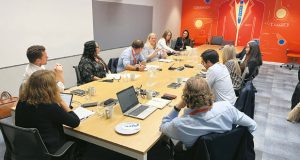 THE CONTRACT CATERER’S VIEW
THE CONTRACT CATERER’S VIEW
ANGUS BRYDON,
MANAGING DIRECTOR, BM
We are absolutely seeing continuous sales growth across our B&I contracts, and although employees are in the office on fewer days, they are spending more time in the buildings when they are there, and spending more on those days than they used to.
We are also seeing more highly subsidised offers at certain locations to reward people coming into the office. Catering and food are now seen as a huge employee incentive.
To support the new hybrid working environment, we have worked with clients to deliver a different model of B&I catering to what we had before. This whole period has been about adaptability and flexibility.
While we previously served quite distinct breakfast and lunch segments, the trend has shifted towards all-day grazing, so we’ve changed our offer to address that. We’re seeing an increase in footfall but also an emerging all-day culture in our workplace restaurants. There’s a constant churn of people now.
It is true to say that we are being challenged by inflation, but we’re working on minimising the impact of that on our clients in partnership with our suppliers, diverting our supply chain slightly where needed and proactively managing our client’s money.
Product availability is obviously an issue and that problem doesn’t appear to be going away anytime soon, so it’s important to manage the sales mix. We’re exploring how we can menu engineer to ensure the best value for both the client and end consumer.
A major challenge that we face with hybrid working is the labour force. There may be higher demand with more people in on a Tuesday-Thursday, for example, so we have to be mindful of rotas and staffing. We have to be responsible with the client’s money, to which end we’ve been offering staff training and tailoring resources to make things happen on down days (i.e Mondays and Fridays).
The journey that we have been on as an organisation, in which we have managed to retain a high proportion of clients and even grown beyond pre-COVID levels, is because we have acted as a trusted advisor to clients. I would say this is always the best approach so that we retain flexibility to adapt to shifting trends and market conditions while also delivering a quality B&I catering service that ticks all the boxes for our clients, consumers and the planet.
 THE SERVICE SUPPLIER’S VIEW
THE SERVICE SUPPLIER’S VIEW
CHARLES ABRAHAM,
FOOD PLATFORM DIRECTOR, SODEXO UK & IRELAND
The impact of hybrid working, for many, has provided choice and flexibility but for service providers it presents a number of challenges. Where pre-pandemic catering teams knew roughly how many people they need to cater for on a daily basis, today the change in working patterns means numbers fluctuate and there is less consistency, perhaps with higher peaks of demand and lower troughs than before. Therefore, food service providers need to become better at using data to forecast demand and ensure that operationally, both in terms of workforce and food they can adapt for quieter and busier days.
The role of food in society and culture is often central in bringing people together and that too applies to the workplace. As clients consider how to incentivise and make the workplace appealing for their people to return, food service providers can support this by providing the right food offer as part of an overall workplace strategy. Furthermore, as consumers we have all become used to using apps and digital channels to purchase goods and services and for food service providers there is an opportunity for them to use technology to offer a consistent and engaging consumer journey.
We all know that many people take what they eat very seriously and for food service providers, understanding and acting on the importance of nutrition, health and wellbeing, as well as having strong environmental standards are important pillars for any offer, and it is crucial that they are provided with choice when it comes to deciding what they would like to eat.
The fluctuation in service demand, rising food costs and environmental concerns has also put a greater focus on waste. Looking and understanding the drivers of waste is key to tackling it and technology can help with all of these factors. We have been using our WasteWatch programme for a number of years and are accelerating its deployment across client sites to aid our catering teams in monitoring waste in their kitchens which is helping them manage the cost of delivering food services to the standards expected.
Our supply chain team, dietitians and chefs work closely together, regularly reviewing our menus. This work has led to more recipes being developed using less red meat and a higher proportion of plant-based proteins, addressing the increasing consumer demand for healthier, more sustainable foods and as part of our commitment to reduce our carbon footprint. It is the combination of their expertise and skills that enable us to manage the impact of the rising food costs while continuing to serve tasty, healthy and sustainable dishes.
 THE FM CONSULTANT’S VIEW
THE FM CONSULTANT’S VIEW
JOE PARFITT,
MANAGING PARTNER AT LITMUS PARTNERSHIP
Since businesses reopened, hybrid working – the flexible work model that supports a blend of in-office, remote, and on-the-go workers – has been widely adopted. Never before have workplaces looked so different. Couple this with increasing levels of inflation, energy and staffing issues, and it’s challenging to still provide affordable, nutritional choices on menus.
Relationships with suppliers and service providers have never been more important. Working together collaboratively to navigate these challenges and come up with solutions is essential. Customer best value is the key driver and must be achieved – not only in a monetary sense but in all areas of service – getting the balance wrong now will make the difference between staying afloat or potentially sinking.
The current market conditions mean it can be difficult for any organisation to understand if they are receiving value for money with regards their catering service providers. Businesses only know what their suppliers and service providers offer; they don’t know what others are paying or what’s included in their service agreement. Without having this broader sense of what ‘good’ looks like, it’s impossible to know.
This is where benchmarking comes in. Businesses could commission an independent benchmark of their product basket to ensure their supplier is delivering competitive value. Once that’s done, they can also engage with the supply chain to discover what product switches are possible without sacrificing quality or affecting their allergen risks. The benchmark could also cover overall operating costs to understand whether an operation is running within accepted tolerances.
Similarly, there is a lot that suppliers can do to adapt and help their clients navigate through the coming year. Absolutely key to everything is operating with an open and honest dialogue. Often, particularly when the climate is tough, we see communication dry up as conversations can feel difficult. However, the reality is that with current market conditions we’re all facing obstacles and challenges that are much better shared – and solutions found.
It’s also important to keep clients updated about how supply chain challenges are affecting the industry, and what is being done to mitigate these challenges. Some tariff increases or drop in gross profit could be negotiated, but it’s important to engage with clients to regularly collaborate, and so avoid surprises.
Menus can be re-engineered to reflect what is both readily available and affordable. This is a process that can be done jointly with the client and service providers. This is likely to require a more dynamic menu planning process than a traditional menu cycle allows, but it presents an opportunity to surprise and delight consumers if the offer is well communicated. Increasing the relative volume of plant-based dishes on the menu is also a good idea as it reduces unsustainable meat options and lowers cost.
Utilising sales data will inform trading strategies. So, interrogate the data to understand what is popular, profitable and at what times of the day and week resource is needed. Making changes to operating hours, how staff are deployed and the product mix can make a real difference to how efficiently the operation is run.
Technology also has its place and I think we’ve all heard the benefits of implementing pre-ordering systems, loyalty promotions and so on. But innovation is about more than just tech – employee development, engagement and empowerment can lead to the best ideas and attract and retain the best people; which in the current climate is incredibly valuable.




